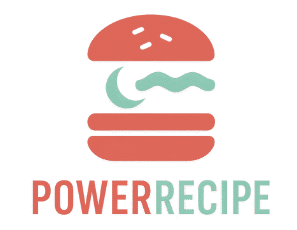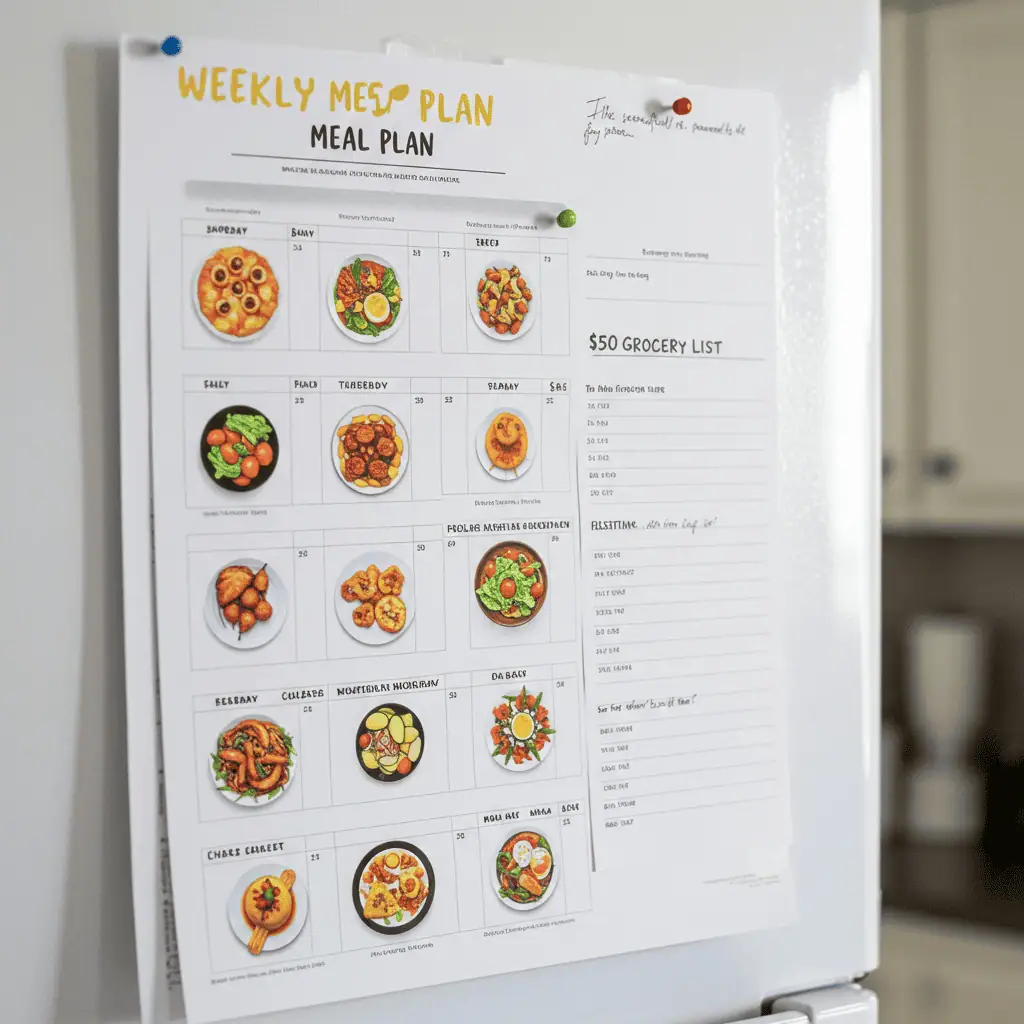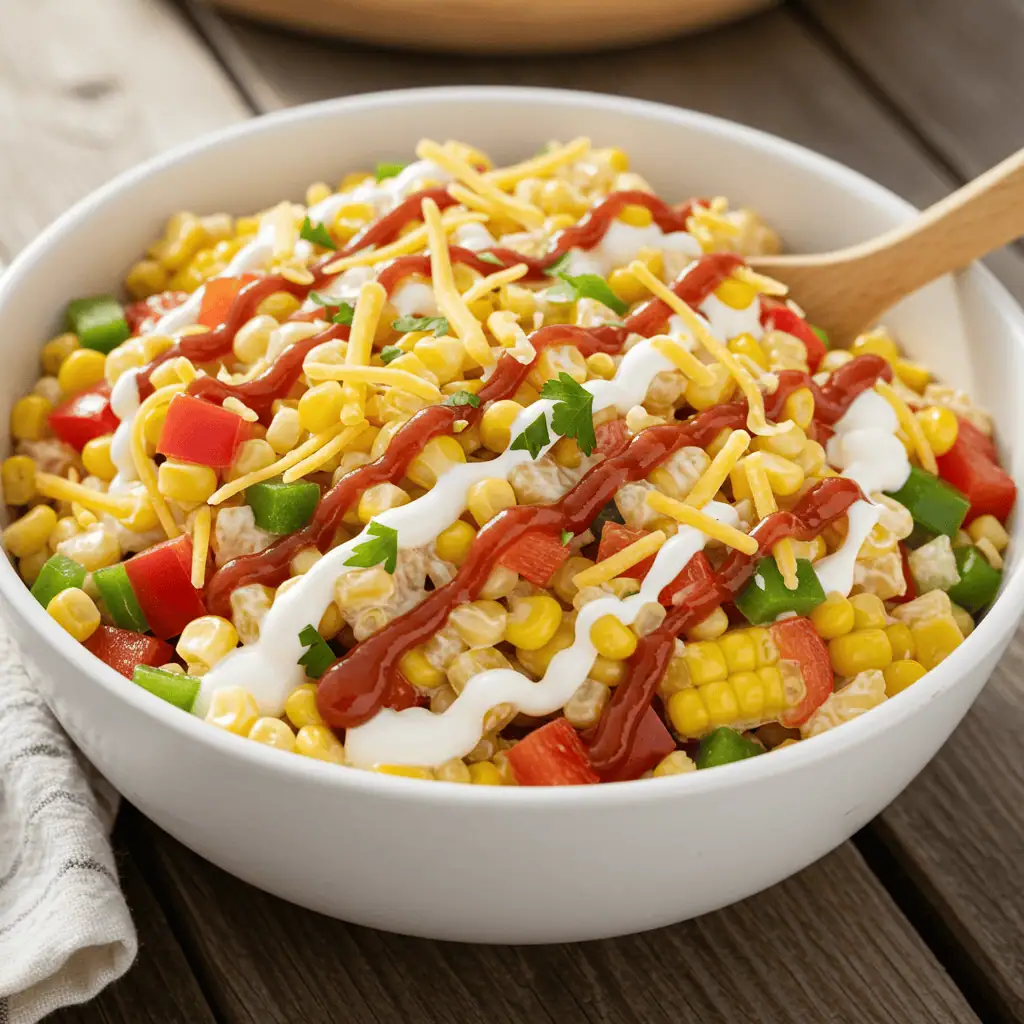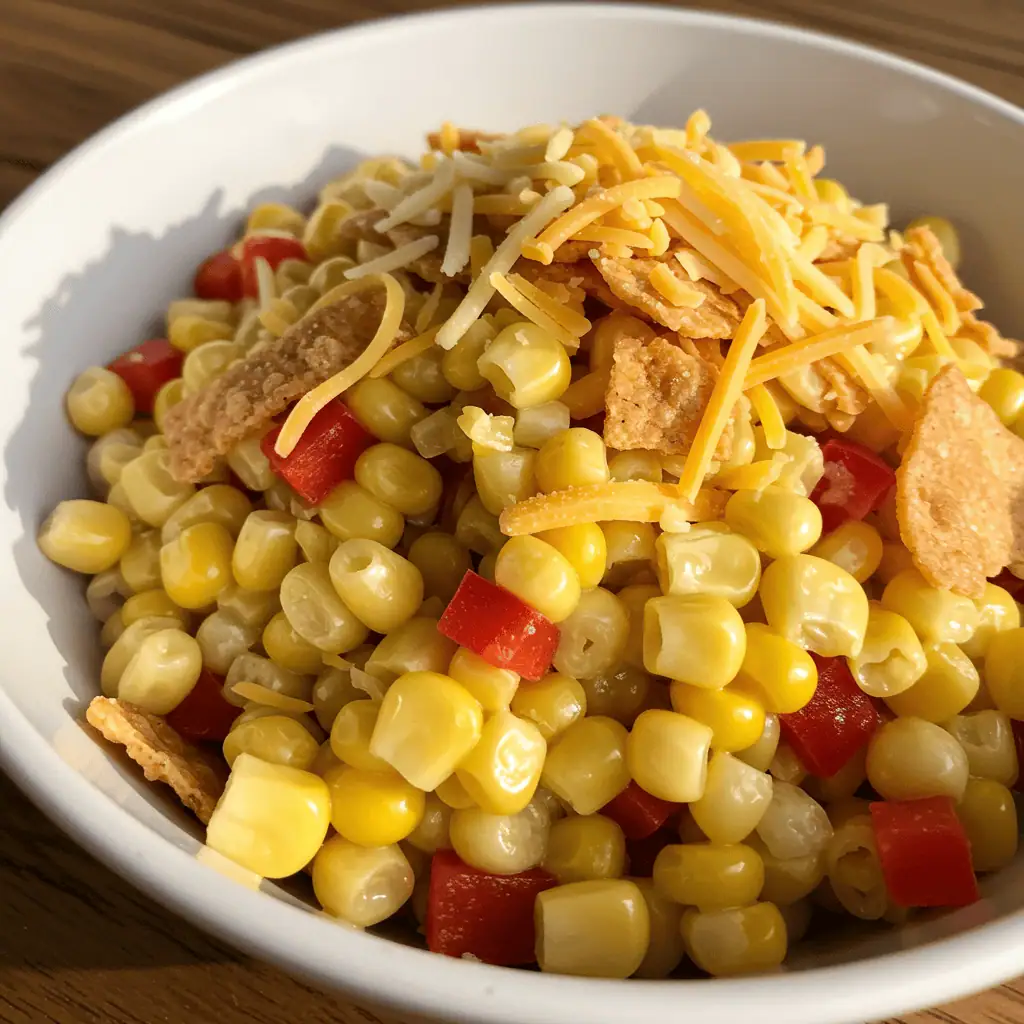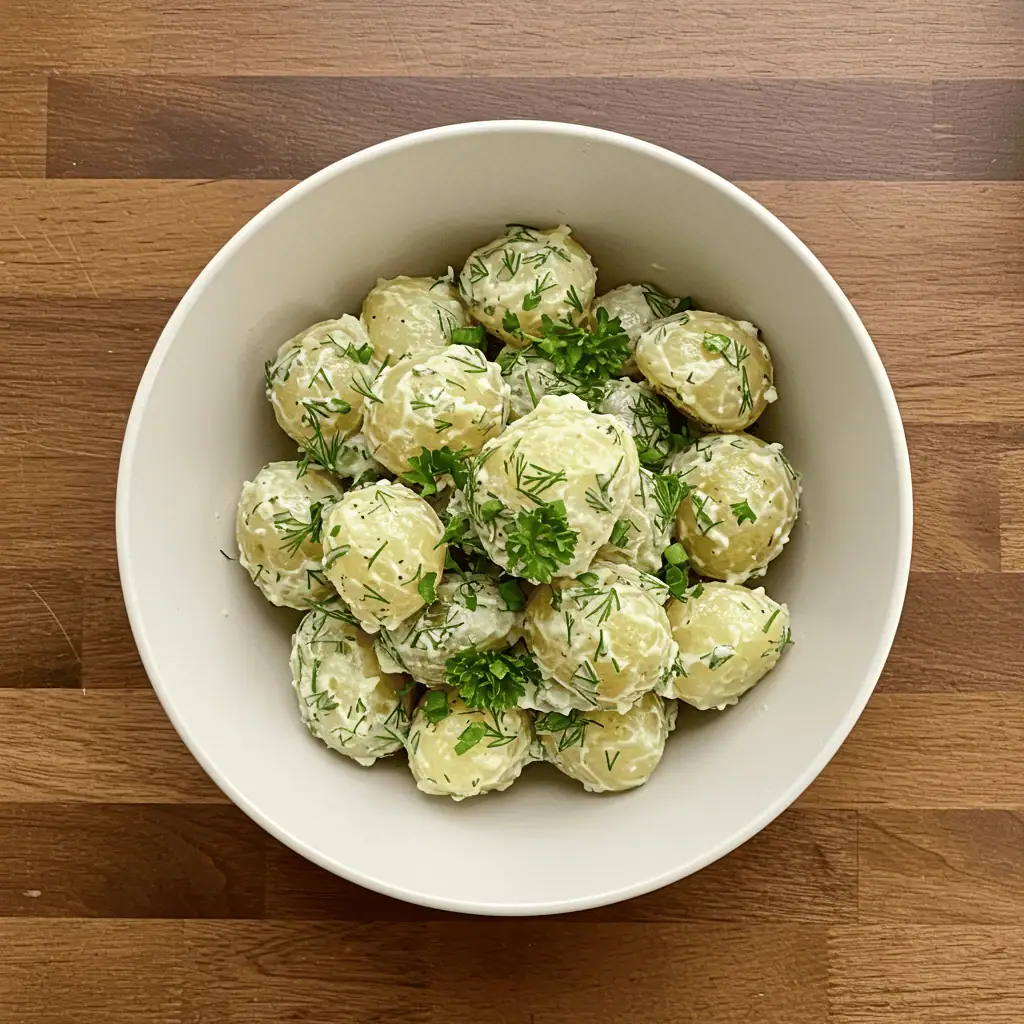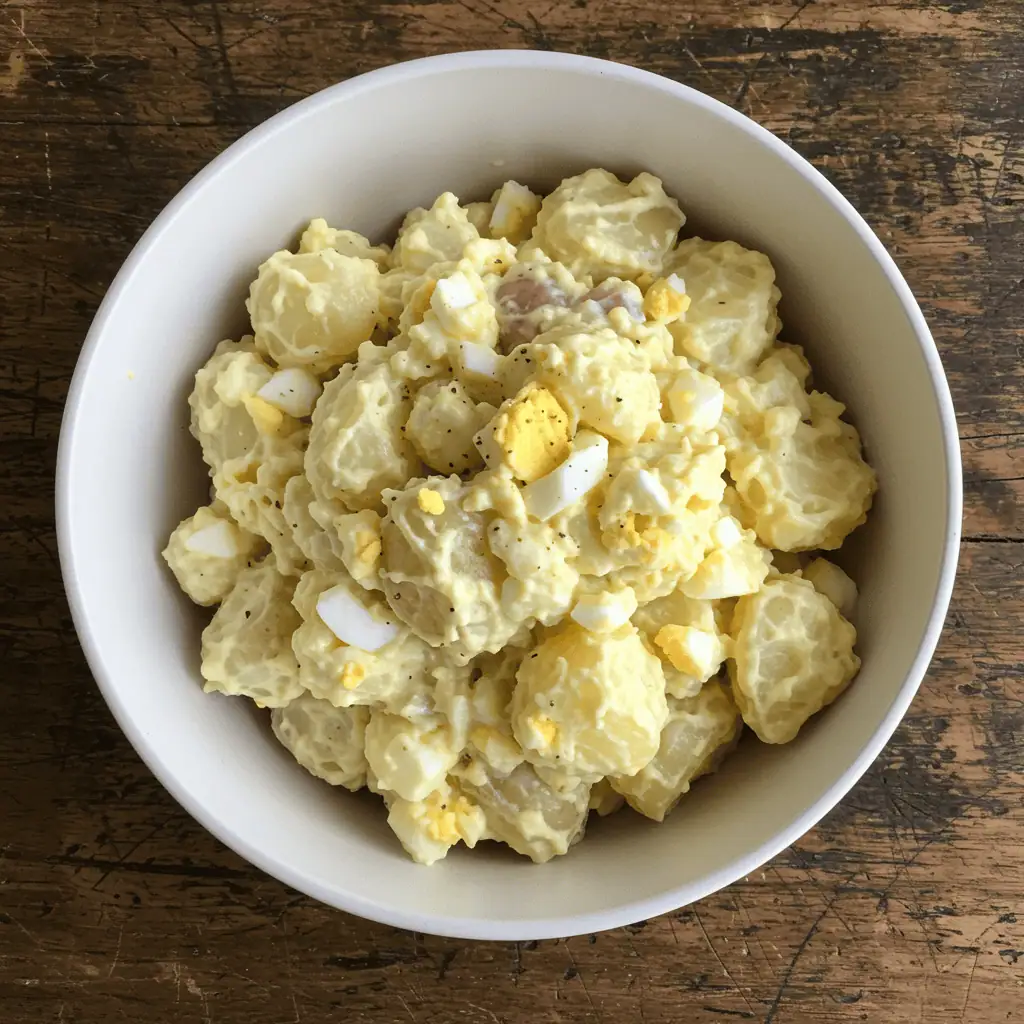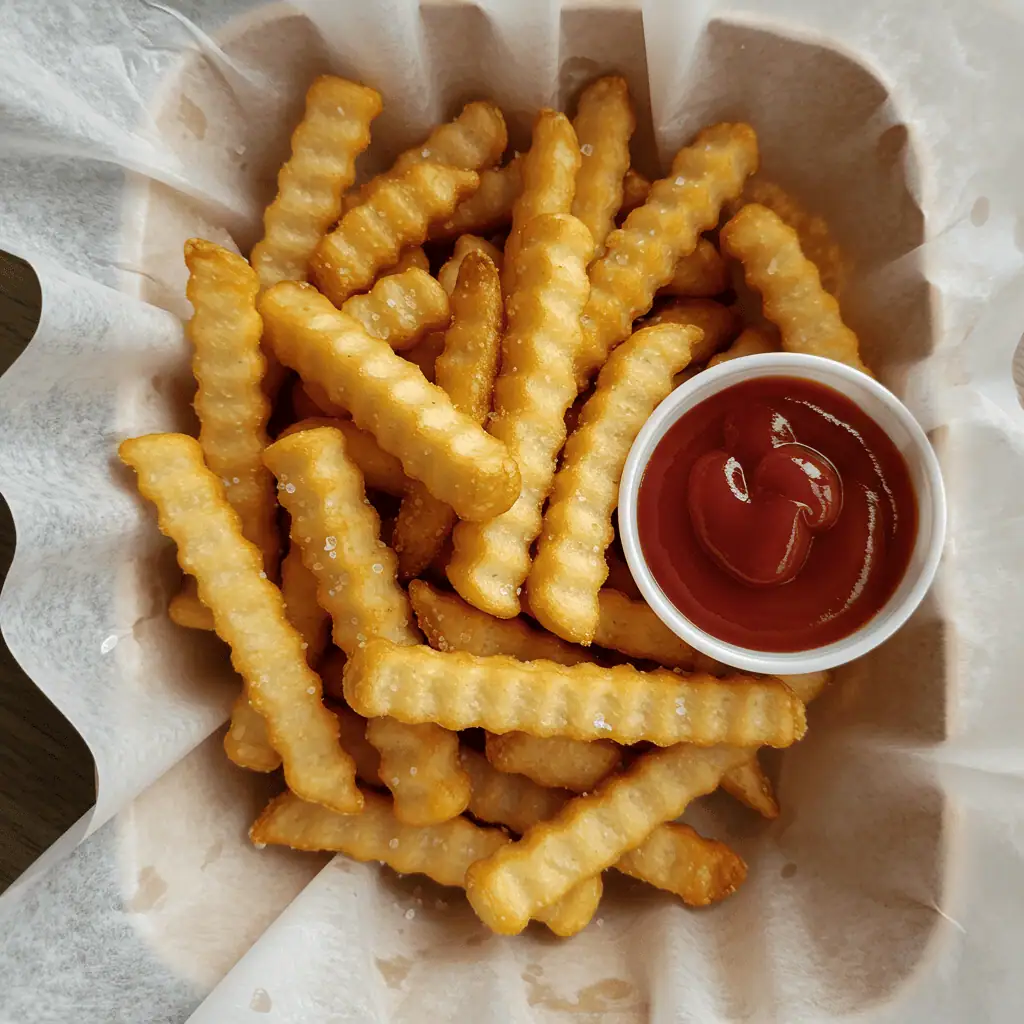Cottage Cheese Wrap No Egg – The Best Guide to Egg-Free, High-Protein Wraps
Introduction
Looking for a healthy, protein-packed wrap that doesn’t rely on eggs? You’re not alone. The rise in egg allergies, dietary restrictions, and plant-based preferences has led many to explore new ways to enjoy nutritious wraps—without cracking a single egg. This guide is all about one of the best alternatives out there: the cottage cheese wrap no egg.
Whether you’re following a low-carb diet, trying to build muscle with high-protein meals, or simply exploring creative recipes, this article will show you how to make delicious egg-free cottage cheese wraps. You’ll learn how cottage cheese can replace eggs in texture and nutrition, how to prepare and store your wraps, and which protein-rich ingredients to pair them with.
Don’t miss our vegetarian lunch recipes if you’re looking to expand your meal rotation.
Why Choose a Cottage Cheese Wrap with No Egg?
Health Benefits of Egg-Free Wraps with Cottage Cheese
Choosing cottage cheese wraps without eggs can benefit various dietary needs. For starters, it’s a great option for those with egg allergies, lactose sensitivities (with lactose-free cheese), or anyone watching their cholesterol. Unlike traditional wraps that use flour or eggs, cottage cheese wraps are often gluten-free, low-carb, and high in protein.
Cottage cheese is rich in casein protein, which digests slowly and supports muscle recovery. It’s also lower in calories compared to other cheese types and is a good source of calcium, phosphorus, and vitamin B12—perfect for supporting bone and nerve health.
Why People Are Ditching Eggs in Wraps Today
From ethical reasons to digestive issues, there’s a growing trend to cut out eggs. Many people are turning to dairy-based alternatives, like cottage cheese, to replicate the binding and richness that eggs provide. Plus, the recent rise in egg prices and concerns about salmonella have further encouraged this shift.
Eliminating eggs doesn’t mean compromising taste or texture. In fact, with the right technique, you won’t even notice they’re missing from your wraps.
Cottage Cheese vs Eggs: Nutritional Breakdown for Wrap Recipes
Let’s break down the nutrition comparison in a simple table:
| Nutrient (per 100g) | Cottage Cheese | Whole Egg |
|---|---|---|
| Calories | 98 | 143 |
| Protein | 11g | 13g |
| Fat | 4.3g | 9.5g |
| Cholesterol | 17mg | 373mg |
| Calcium | 83mg | 56mg |
As you can see, cottage cheese is lower in fat and cholesterol while still offering a solid dose of protein. It’s ideal for anyone looking to lighten up their meals without sacrificing nutrition.
Looking for inspiration? Try our 30-minute low-cholesterol meals to pair with your wraps.
Can You Make Cottage Cheese Wraps Without Eggs?
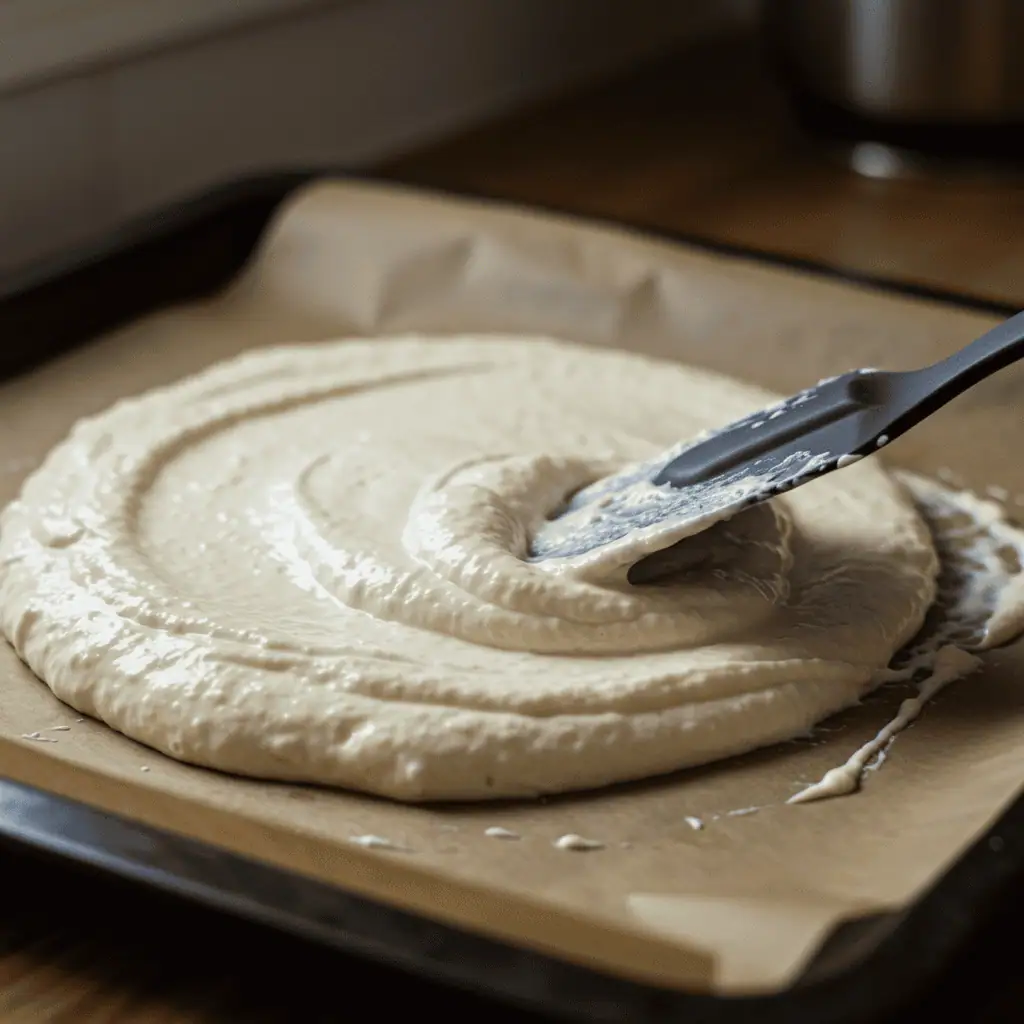
Yes, You Absolutely Can – Here’s Why It Works
The short answer is: Yes, you can definitely make cottage cheese wraps without eggs, and they hold up beautifully. Cottage cheese has a naturally creamy, thick consistency that, when blended and cooked, firms up nicely—especially when paired with simple binding ingredients like psyllium husk, flaxseed meal, or even almond flour.
Cottage cheese contains casein, a milk protein that gives the wrap structure when heated. It creates a bendable but sturdy base that can be rolled or folded, just like a classic tortilla or egg wrap. This makes it perfect for those avoiding eggs due to allergies, dietary preferences, or personal taste.
Don’t miss our cottage cheese egg bites if you’re curious about how cottage cheese behaves in egg-like recipes.
How Texture and Binding Are Achieved Without Eggs
To replicate the “glue” effect that eggs usually provide, you need binders that can absorb moisture and hold ingredients together. Here are three great egg-free binders:
- Ground flaxseed (flax egg) – Just one tablespoon mixed with water mimics egg binding.
- Psyllium husk – Adds fiber and absorbs excess liquid for firm wraps.
- Tapioca or arrowroot starch – Great for adding elasticity and helping with pliability.
You simply blend the cottage cheese with your chosen binder and spread it thinly on parchment paper to bake. The result? A flexible, protein-rich wrap that doesn’t fall apart.
Real Reviews: People Who Tried No-Egg Cottage Cheese Wraps
Many home cooks and food bloggers report surprisingly good results when ditching eggs. Here’s what people are saying:
- “I was skeptical at first, but the texture was spot on! I added garlic powder and spinach, and it turned out amazing.”
- “I used ground flax and baked it for 25 minutes—my husband didn’t even know there were no eggs in it.”
- “These wraps held up well for my lunch meal prep. I rolled them with hummus, cucumbers, and grilled chicken.”
Need a flavorful side to go with your wrap? Discover great ideas like sheet pan eggs with cottage cheese, or turn it into a breakfast burrito using no eggs at all.
Can Cottage Cheese Replace Eggs in Wrap Recipes?
Nutrient Match-Up: How Cottage Cheese Acts as an Egg Substitute
While eggs are often seen as the go-to binding agent in wraps and low-carb recipes, cottage cheese offers a surprisingly comparable alternative. Both are rich in protein and offer moisture and fat that help with the texture and structure of the wrap. But here’s the good news—cottage cheese has less cholesterol and can be used by people who avoid eggs for health or dietary reasons.
Let’s compare the benefits in a quick glance:
| Feature | Eggs | Cottage Cheese |
|---|---|---|
| Protein | 6–7g/egg | 11–13g per ½ cup |
| Cholesterol | 185mg/egg | 15–20mg per ½ cup |
| Fat | 5g/egg | 4g per ½ cup |
| Lactose-free Option? | No | Yes (lactose-free versions available) |
| Binding Capabilities | Excellent | Very Good (when blended and baked) |
Using blended cottage cheese, you can create a creamy base that holds together well when baked. Adding a pinch of flaxseed, almond flour, or cornstarch makes it even more stable. It’s not a 1-to-1 swap in all recipes, but for wraps, it works like a charm.
Smart Cooking: When Cottage Cheese Works Best Without Eggs
Cottage cheese performs best in recipes where:
- You bake or lightly fry the wrap (instead of raw prep).
- You use additional thickeners (like flax meal or coconut flour).
- The goal is a savory, protein-dense meal.
For instance, in a breakfast wrap, using cottage cheese instead of eggs still gives you that creamy, rich bite. If you’re making a veggie-packed lunch wrap, it acts as a flavorful base without overpowering the fillings.
That said, for baked desserts or dishes where egg structure is crucial (like soufflés), cottage cheese may not be the ideal swap. But for wraps? It nails it.
How to Balance Moisture and Consistency Without Eggs
One key factor to using cottage cheese in wraps is moisture control. Cottage cheese can be wet, so here are tips to avoid soggy wraps:
- Drain the cheese – Use a fine sieve or cheesecloth to remove excess liquid.
- Blend it smooth – A food processor or blender helps with consistency.
- Add fiber – Psyllium husk, oat fiber, or almond flour absorb moisture.
- Don’t overbake – Bake just enough to dry out the base without cracking it.
The wrap should be pliable and firm but not rubbery. If it cracks or feels too soft, try adjusting the moisture level or adding a bit more fiber to your batter.
Looking for other creative meal prep tricks? Check out healthy breakfast sausage recipes for more high-protein inspiration.
How to Make Cottage Cheese Wraps – No Eggs Needed
Essential Ingredients for Egg-Free Cottage Cheese Wraps
Creating egg-free cottage cheese wraps doesn’t require complicated or pricey ingredients. In fact, you probably already have most of them in your kitchen. Here’s a simple list of what you’ll need:
Basic Ingredients:
- 1 cup cottage cheese (drained if watery)
- 2 tablespoons almond flour (or oat flour)
- 1 tablespoon ground flaxseed (for binding)
- 1/4 teaspoon garlic powder (optional, for flavor)
- Salt and pepper to taste
Optional Add-Ins:
- 1/2 teaspoon dried herbs (basil, oregano, or parsley)
- 1 tablespoon nutritional yeast (for a cheesy flavor)
- Chopped spinach or grated zucchini (for veggie wraps)
This recipe yields about 2–3 medium-sized wraps, depending on the thickness.
Pro Tip: Use lactose-free cottage cheese if you’re dairy-sensitive.
Step-by-Step Recipe with Cooking Tips
Here’s how to turn that simple ingredient list into flexible, egg-free, protein-packed wraps:
- Preheat Oven:
Set your oven to 350°F (175°C). Line a baking tray with parchment paper or a silicone baking mat. - Blend the Batter:
In a food processor, combine cottage cheese, almond flour, flaxseed, seasonings, and any optional herbs or veggies. Blend until smooth. The mixture should be thick but spreadable. - Spread on Tray:
Use a spatula to spread the batter thinly (about 1/8 inch thick) into round or rectangular shapes on the parchment paper. - Bake:
Bake for 25–30 minutes, or until edges are golden and the center is firm to the touch. Be careful not to overbake or the wrap may become brittle. - Cool & Peel:
Let the wraps cool completely before peeling them off the parchment. This prevents tearing. - Store or Fill:
Use right away with your favorite filling, or store in an airtight container in the fridge for up to 3 days.
Looking for something creative to add in? Don’t miss our cheap meal prep ideas for wrap-friendly fillings and budget-friendly protein options.
Common Mistakes to Avoid in No-Egg Wraps
Even simple recipes can go wrong without the right technique. Here are a few things to watch out for:
- Skipping the draining step: Too much moisture will lead to soft, soggy wraps that tear easily.
- Spreading too thick: A thicker wrap takes longer to cook and may crack when rolled.
- Overbaking: This dries out the wrap and makes it brittle. Start checking at the 25-minute mark.
- Not letting them cool: Peeling the wrap too early will cause sticking and tearing.
Stick with these tips, and you’ll have flexible, satisfying wraps that are perfect for breakfast, lunch, or meal prep.
Protein Boosting Additions for Cottage Cheese Wraps
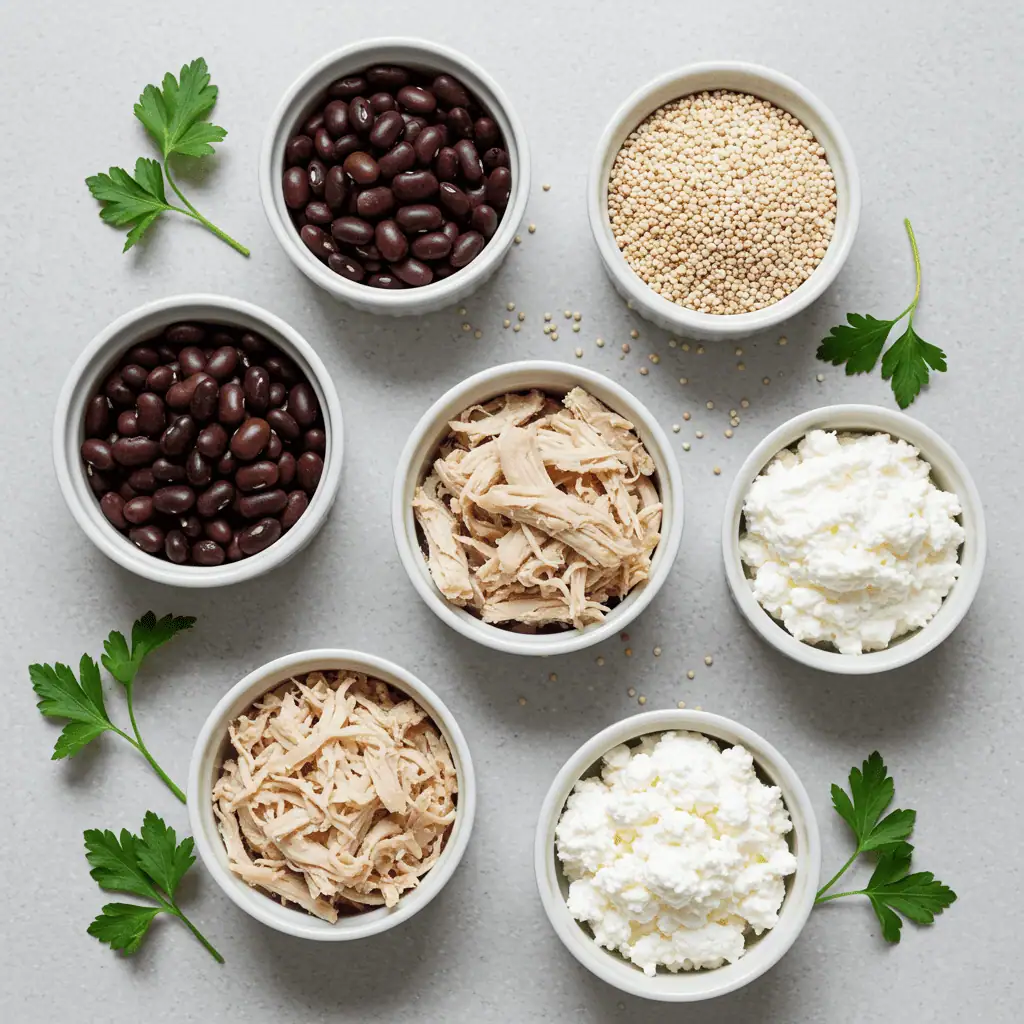
Top High-Protein Add-Ins: Lentils, Quinoa, Beans, and More
Cottage cheese already delivers a solid amount of protein, but if you’re aiming to maximize your macros, you can easily bump up the numbers with some smart add-ins. Here are high-protein options that pair beautifully with egg-free cottage cheese wraps:
| Ingredient | Protein (per 100g) |
|---|---|
| Cooked Quinoa | 4.1g |
| Black Beans | 8.9g |
| Lentils | 9g |
| Grilled Chicken | 27g |
| Tofu | 10g |
| Tempeh | 19g |
| Tuna (canned) | 25g |
| Edamame | 11g |
Add-ins can be blended into the wrap base, or simply used as fillings. Quinoa and lentils, for example, can be cooked and added directly into the batter to add texture and volume. Grilled chicken or tofu makes excellent high-protein stuffing.
Looking to complement your wrap with a hearty salad? Discover great ideas like our American salads recipe that balance flavor and protein content.
Mix & Match: Flavorful Ways to Enhance Your Wrap
To avoid bland wraps, mix up your ingredients and flavors. Here are some fun and functional combos that bring the flavor and protein punch:
- Mediterranean Style: Cottage cheese base + cooked lentils + sun-dried tomatoes + olives
- Tex-Mex Wrap: Black beans + cumin + shredded lettuce + corn + avocado
- Veggie Power: Quinoa + sautéed spinach + feta + roasted bell peppers
- Keto Wrap: Tuna + cheese + arugula + avocado mayo
These combos not only up your protein intake but also keep your wraps exciting and satisfying. Aim to include 20–25g of protein per serving if you’re eating these post-workout or as a main meal.
Balancing Macros: High-Protein and Low-Carb Options
Many people choose cottage cheese wraps as a low-carb alternative to tortillas or bread. With the right additions, you can keep it low in carbs while high in protein and fiber.
| Macro Focus | What to Add |
|---|---|
| High-Protein | Chicken, egg whites, turkey, tofu |
| Low-Carb | Spinach, zucchini, olives, nuts |
| High-Fiber | Chia seeds, flax, psyllium husk |
| Low-Fat | Tuna in water, cottage cheese |
If you’re following a low-carb or keto lifestyle, stick with leafy greens, lean protein, and healthy fats to complement the cottage cheese.
Don’t miss our recipe on how much protein is in mozzarella cheese stick if you’re planning to layer in cheese as part of your wrap fillings.
Best Filling Combinations for Cottage Cheese Wraps
Savory Options: Grilled Veggies, Chicken, and More
One of the best things about cottage cheese wraps with no egg is their versatility. They’re a blank canvas ready to hold an endless variety of savory fillings. Here are some flavorful combos to elevate your meal:
1. Grilled Veggie Wrap
- Zucchini, bell peppers, onions, and mushrooms
- Add a sprinkle of feta and a drizzle of balsamic glaze
2. Chicken Caesar-Style
- Grilled chicken breast
- Romaine lettuce and shaved parmesan
- Light Caesar dressing
3. Spicy Hummus & Veggies
- Roasted red pepper hummus
- Carrots, cucumbers, and spinach
- A dash of crushed red pepper
4. Turkey Avocado Crunch
- Smoked turkey breast
- Sliced avocado
- Shredded lettuce and pickled onions
Each combo packs nutrition, texture, and flavor, offering a satisfying lunch or dinner that’s easy to prep.
Looking for something to pair with these wraps? Don’t miss our halal chicken wrap with garlic sauce for even more delicious wrap ideas.
Sweet and Spicy Fusion Ideas
Sweet and spicy fillings can surprise your palate in the best way. Cottage cheese wraps don’t always have to be savory—mix it up with these fusion favorites:
1. Mango Jalapeño Delight
- Diced mango, chopped jalapeños
- Red cabbage and lime juice
2. Apple Cinnamon Walnut
- Sliced apples
- Ground cinnamon and chopped walnuts
- Drizzle of honey (or sugar-free syrup for keto)
3. Thai-Inspired Peanut Chicken
- Shredded chicken
- Slaw mix and peanut sauce
- Sprinkle of crushed peanuts
Fusion wraps are perfect for breaking the lunch routine, bringing bold flavors without adding unnecessary carbs or calories.
Vegan, Vegetarian, and Keto-Friendly Stuffing Options
Whether you’re plant-based or carb-conscious, you can make your wraps fit your dietary goals with the right stuffing. Here’s how:
Vegan Options:
- Grilled tofu or tempeh
- Hummus or guacamole
- Chickpeas, lentils, or roasted sweet potatoes
Vegetarian Options:
- Roasted veggies + goat cheese
- Spinach, mushrooms, and mozzarella
- Hard-boiled egg slices (if vegetarian, not vegan)
Keto-Friendly Options:
- Grilled chicken with avocado
- Tuna salad with olive oil and celery
- Cheese, turkey, and spinach with mayo drizzle
All of these options keep your wraps satisfying, customizable, and nutritious.
Meal Prep and Storage Tips
How to Prep Wraps for the Week Ahead
One of the biggest advantages of cottage cheese wraps with no egg is how well they fit into a meal prep routine. They’re quick to make, store easily, and reheat without falling apart—making them a top choice for busy weekdays.
Here’s how to prep like a pro:
- Batch Bake: Make a double or triple batch of wraps on a weekend. Use two baking sheets at once to save time.
- Cool Completely: Let the wraps cool fully before stacking. This prevents moisture buildup, which can make them soggy.
- Use Parchment Between Wraps: When stacking wraps, place parchment paper between each to avoid sticking.
- Prep Fillings Separately: Store your fillings in individual containers. This helps preserve the texture and freshness of both the wrap and the contents.
Bonus Tip: Keep toppings like avocado, hummus, and dressings in small containers until you’re ready to eat.
Want more prep-friendly recipes? Check out our guide to 4-ingredient slow cooker chicken and stuffing—it pairs perfectly with your wraps.
Storing and Reheating: What You Need to Know
Proper storage extends the life of your wraps and keeps them tasting fresh.
Refrigerator:
Wraps can be stored in the fridge for up to 5 days. Keep them in an airtight container or zip-top bag with parchment between each.
Freezer:
Yes, you can freeze them! Wrap each one individually in plastic wrap or foil, then store in a freezer-safe bag. They’ll last up to 2 months this way.
To Reheat:
- Microwave: 15–20 seconds (wrapped in a damp paper towel)
- Oven/Toaster Oven: 5–7 minutes at 300°F for a crisp edge
- Skillet: Heat on medium for 1–2 minutes per side with a touch of oil for extra crisp
These wraps don’t lose much texture when stored properly, especially if you drain your cottage cheese well before baking.
Looking for more creative, protein-rich breakfast options? Discover great ideas like our banana protein pancakes recipes—another meal-prep favorite.
Creative Variations of No-Egg Cottage Cheese Wraps
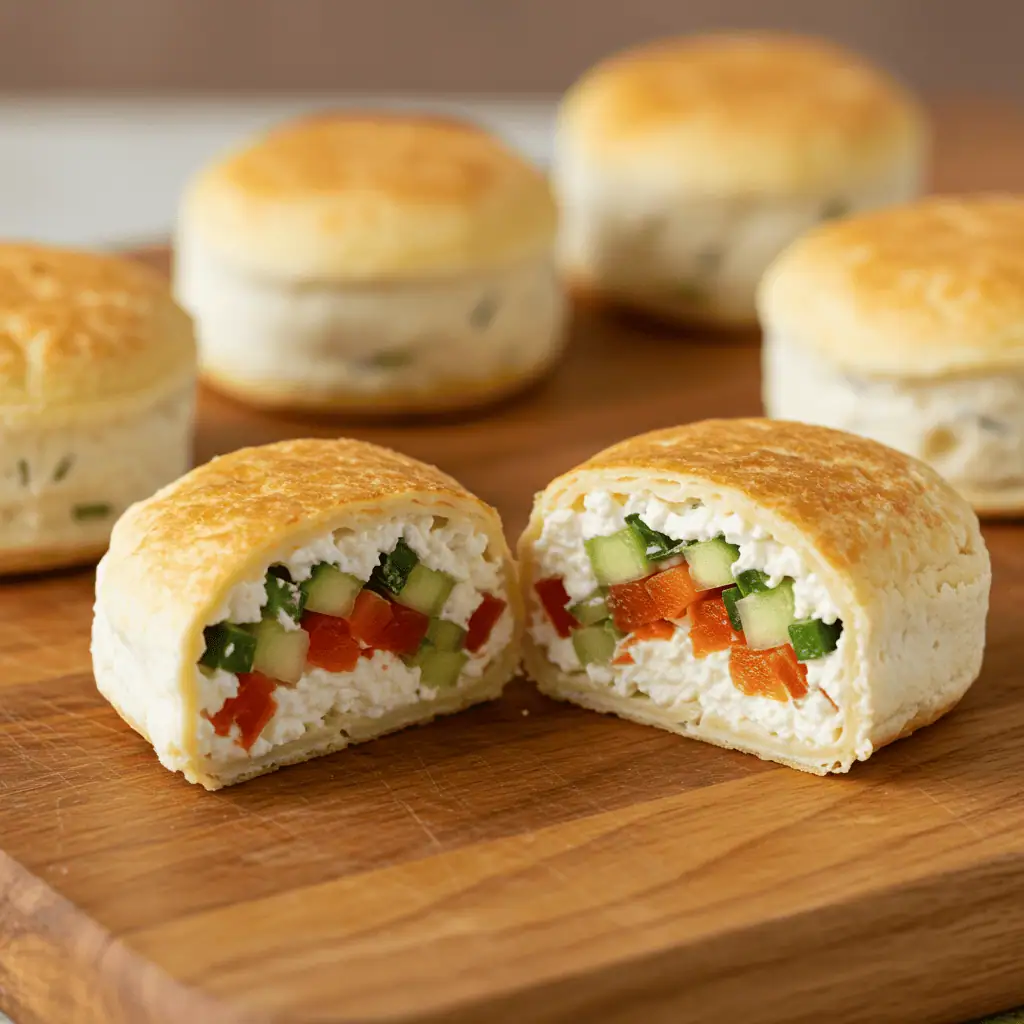
Low-Carb and Gluten-Free Wrap Base Options
If you love experimenting in the kitchen or follow a specific diet, cottage cheese wraps without eggs offer a versatile starting point. Here’s how you can tweak the base to meet your needs:
1. Almond Flour Boost
Swap some of the cottage cheese with almond flour to make the wrap more firm and keto-friendly. This version has fewer carbs and more healthy fats.
2. Psyllium Husk Power Wraps
Add psyllium husk to your base to increase fiber and create a super-flexible wrap. Ideal for low-carb and gluten-free diets, psyllium also improves texture and reduces tearing.
3. Coconut Flour Variant
Using a small amount of coconut flour (start with 1–2 teaspoons) can help absorb moisture and deliver a mildly sweet taste that pairs well with spicy or tangy fillings.
4. Chia Seed Blend
Soak 1 tablespoon of chia seeds in water, then add it to your wrap mix. This boosts omega-3s and helps hold everything together without eggs or grains.
All these versions maintain the original integrity of a cottage cheese wrap—soft, pliable, and full of protein—while catering to different nutritional needs.
Check out our gluten-free desserts if you’re keeping your whole meal gluten-conscious.
Spices and Herbs to Elevate Taste Without Eggs
Plain cottage cheese can be a little bland—but that’s also its strength. It’s a neutral base just waiting for flavor upgrades. Here’s a list of spices and herbs to give your wraps an irresistible twist:
| Spice/Herb | Best Pairing |
|---|---|
| Garlic Powder | Mediterranean or savory fillings |
| Smoked Paprika | Spicy or BBQ-style wraps |
| Cumin | Tex-Mex or Indian-inspired flavors |
| Italian Seasoning | Veggie or pizza-flavored wraps |
| Turmeric | Anti-inflammatory and colorful base |
| Dill | Seafood or cucumber-based wraps |
| Black Pepper | Classic and works with almost any variation |
Don’t be afraid to experiment—just stick to 1/4 to 1/2 teaspoon of spices per batch to avoid overwhelming the cheese flavor.
Kid-Friendly and Snack-Sized Versions
Want a healthy option for school lunches or post-workout snacks? You can easily make mini cottage cheese wraps that are fun-sized and portable.
Kid-Friendly Wrap Ideas:
- PB & Banana Wrap: Add natural peanut butter and banana slices for a protein-rich treat.
- Cheesy Pizza Wrap: Mix in a little shredded mozzarella and marinara for a pizza twist.
- Strawberry Cream Wrap: Blend cottage cheese with a touch of honey and sliced strawberries.
Snack-Sized Prep Tips:
- Use a spoon to portion out smaller batter circles on your baking sheet.
- Bake 5–7 minutes less than the full-sized version.
- Store in airtight snack bags for grab-and-go meals.
These variations are great for the whole family and help reduce food waste if you have leftover ingredients from your main wrap prep.
Nutrition and Dietary Suitability
Is a Cottage Cheese Wrap Without Egg Good for You?
Yes—cottage cheese wraps without eggs are a fantastic choice if you’re looking for a nutrient-dense, high-protein, and low-carb meal option. They’re packed with muscle-supporting casein protein, essential amino acids, and calcium—all while being naturally lower in calories than traditional wraps made with eggs or flour.
Here’s why they’re a smart option:
- Low in carbs: Great for keto and diabetic-friendly meals
- High in protein: Keeps you full and supports muscle repair
- Gluten-free: Safe for celiacs and those avoiding wheat
- Versatile: Can be made vegetarian, low-fat, or high-fiber
And without eggs, these wraps are also suitable for people with egg allergies or those on restricted diets.
Looking for a dish with similar health perks? Don’t miss our quinoa chickpea rainbow bowl benefits—a fantastic, nutrient-rich option.
Dairy Sensitivity, Keto, and Vegetarian Diets
Let’s break down who can eat these wraps and how to modify them if needed.
1. For Dairy-Sensitive Eaters:
Use lactose-free cottage cheese, widely available in most grocery stores. It’s easier on digestion but still offers the same protein benefits.
2. For Keto Dieters:
These wraps are naturally low in carbs. Pair them with high-fat, low-carb fillings like avocado, cheese, grilled meats, or olive tapenade for a satisfying keto-friendly meal.
3. For Vegetarians:
Use plant-based fillings like tempeh, beans, lentils, or tofu. Add in leafy greens, herbs, and spices to enhance both the nutrition and flavor profile.
4. For Weight Loss:
Cottage cheese is low in calories but high in protein, which increases satiety and reduces overall calorie intake. Choose light fillings like grilled vegetables, lean protein, and low-fat dressings.
Macros, Calories, and Full Nutritional Chart
Here’s a sample nutrition breakdown for 1 standard cottage cheese wrap (without fillings):
| Nutrient | Amount |
|---|---|
| Calories | 105 kcal |
| Protein | 12g |
| Total Fat | 4.5g |
| Carbohydrates | 3g |
| Fiber | 1g |
| Sugars | 2g |
| Sodium | 270mg |
| Calcium | 10% DV |
Of course, the exact numbers will vary depending on your add-ins and portion size, but these wraps make a solid foundation for balanced meals across most eating plans.
Looking to balance your meals even further? Explore our power bowl recipes vegan that pair well with wraps and cover your nutrient bases.
Frequently Asked Questions (FAQ)
Can you make cottage cheese wraps without eggs?
Absolutely. You can make soft, flexible, and tasty cottage cheese wraps without eggs by using simple binding alternatives like ground flaxseed, psyllium husk, or almond flour. These wraps are easy to bake and hold up just as well as traditional egg-based wraps. They’re ideal for anyone with egg allergies or following a low-cholesterol diet.
Can cottage cheese be used as an egg substitute?
Yes, cottage cheese can replace eggs in specific recipes—especially savory ones like wraps, pancakes, or casseroles. While it may not work in baking where eggs provide structure and lift, it’s an excellent binding and moisture-rich substitute in dishes where creaminess and protein matter most.
How do you make cottage cheese wraps?
To make cottage cheese wraps, blend cottage cheese with binders like flaxseed and almond flour, season it, then spread thin on parchment paper and bake at 350°F for about 25–30 minutes. Let it cool and gently peel off the sheet. You can customize the recipe with herbs, spices, or even add-ins like spinach for extra nutrients.
What can I add to cottage cheese to increase protein?
To boost the protein in cottage cheese wraps, try mixing in cooked lentils, black beans, shredded chicken, edamame, or quinoa. You can also top your wraps with lean proteins like turkey or tofu. For a quick hit of protein, stir in a spoon of unflavored whey protein powder into the batter—just make sure to adjust moisture levels accordingly.
Conclusion
Cottage cheese wraps without eggs are a game-changer in the world of clean eating and protein-rich meal prep. Whether you’re cutting back on eggs, avoiding allergens, or simply looking for a new low-carb wrap alternative, this egg-free option checks all the boxes: flexible, satisfying, easy to make, and endlessly customizable.
From meal prep tips to high-protein add-ins and savory fillings to sweet fusions, these wraps can be adapted to fit nearly every dietary lifestyle—from keto to vegetarian and everything in between. They’re ideal for breakfast, lunch, snack time, or post-workout fuel.
Looking for inspiration? Try our healthy pasta salad with tuna as a high-protein side to complement your wrap.
Start with the base recipe, adjust to your taste and macros, and enjoy the endless variety. With a little prep and creativity, you’ll never need to rely on eggs again to enjoy delicious, nutrient-packed wraps.
Print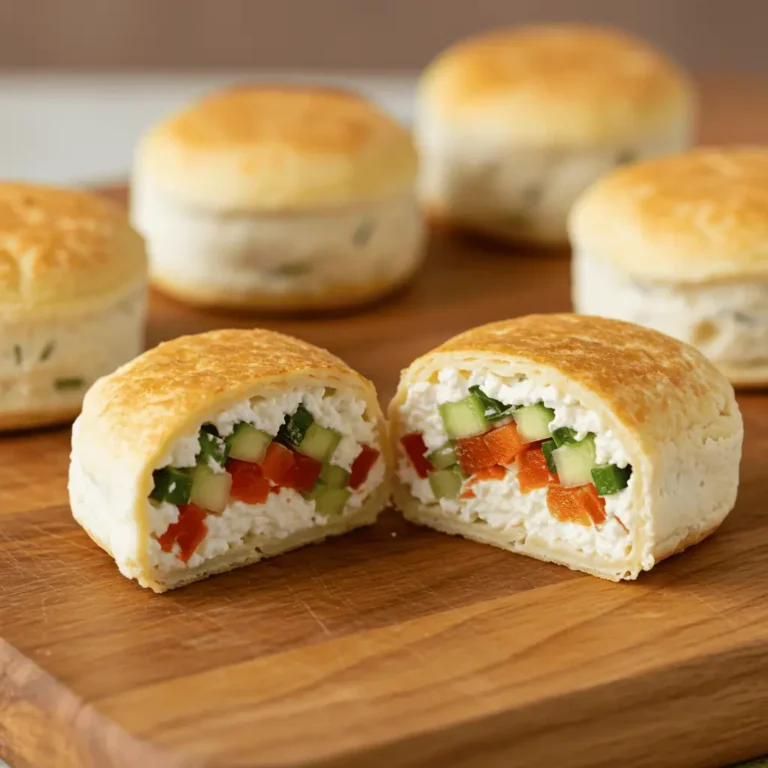
Cottage Cheese Wrap No Egg – Best High-Protein Egg-Free Wrap Guide
5 Stars 4 Stars 3 Stars 2 Stars 1 Star
No reviews
A soft, flexible, and protein-packed wrap made with cottage cheese and no eggs—perfect for low-carb, high-protein diets. This simple egg-free wrap is great for meal prep, gluten-free diets, and anyone looking for a healthy alternative to traditional tortillas.
- Total Time: 30 minutes
- Yield: 2–3 medium wraps 1x
Ingredients
1 cup cottage cheese (drained)
2 tablespoons almond flour
1 tablespoon ground flaxseed
1/4 teaspoon garlic powder (optional)
Salt and pepper to taste
Optional: 1/2 teaspoon dried herbs (e.g., parsley or basil), chopped spinach
Instructions
Preheat oven to 350°F (175°C). Line a baking sheet with parchment paper.
Blend cottage cheese, almond flour, flaxseed, and seasonings in a food processor until smooth.
Spread the batter into thin circles or rectangles on the lined baking tray (about 1/8 inch thick).
Bake for 25–30 minutes or until firm and lightly golden at the edges.
Cool completely before peeling off the parchment. Use immediately or store for later.
Notes
For firmer wraps, add 1 teaspoon psyllium husk or 1 extra tablespoon almond flour.
These wraps store well in the fridge for up to 5 days. Freeze for up to 2 months.
Wraps pair well with grilled chicken, hummus, quinoa, or roasted vegetables.
Use lactose-free cottage cheese if dairy-sensitive.
- Author: Asmaa Nour
- Prep Time: 5 minutes
- Cook Time: 25 minutes
- Category: Wraps / Meal Prep
- Method: Baking
- Cuisine: Global Fusion
- Diet: Gluten Free
Nutrition
- Serving Size: 1 wrap
- Calories: 105 kcal
- Sugar: 2g
- Sodium: 270mg
- Fat: 4.5g
- Saturated Fat: 2.5g
- Unsaturated Fat: 2g
- Trans Fat: 0g
- Carbohydrates: 3g
- Fiber: 1g
- Protein: 12g
- Cholesterol: 17mg
